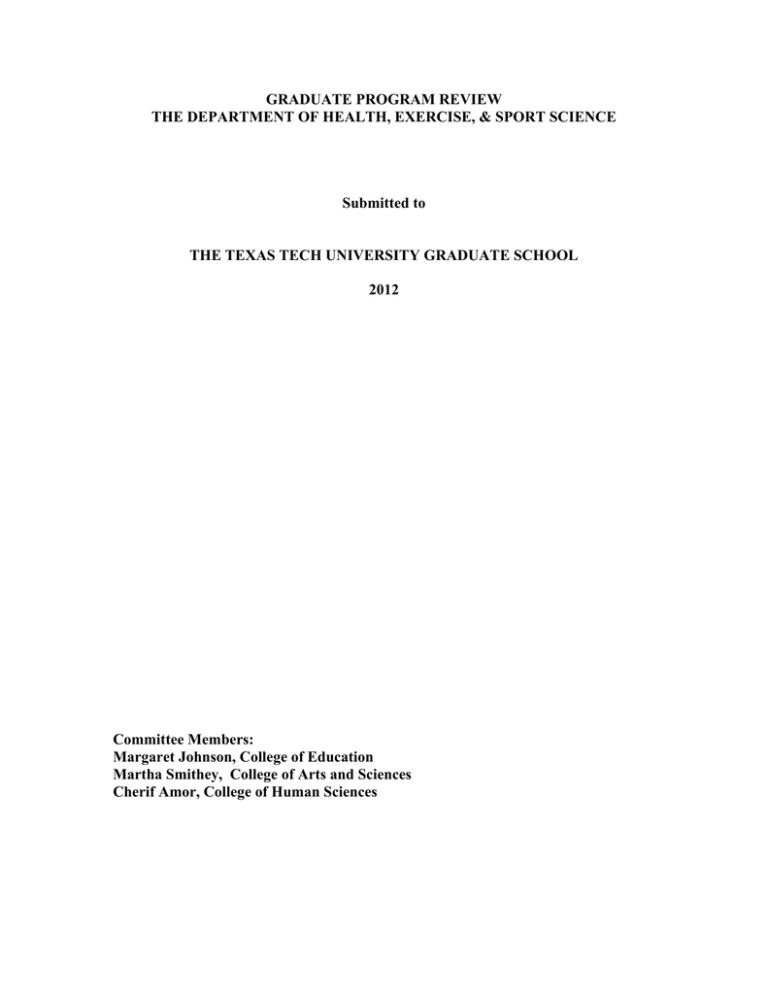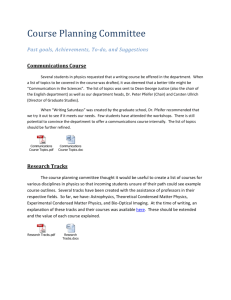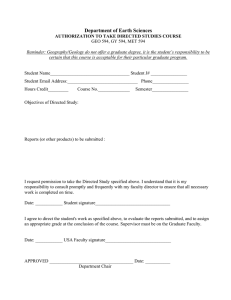GRADUATE PROGRAM REVIEW THE DEPARTMENT OF HEALTH, EXERCISE, & SPORT SCIENCE
advertisement

GRADUATE PROGRAM REVIEW THE DEPARTMENT OF HEALTH, EXERCISE, & SPORT SCIENCE Submitted to THE TEXAS TECH UNIVERSITY GRADUATE SCHOOL 2012 Committee Members: Margaret Johnson, College of Education Martha Smithey, College of Arts and Sciences Cherif Amor, College of Human Sciences Introduction The review team consisted of Cherif Amor, Martha Smithey, and Margaret Johnson. Heather Webb from Mississippi State University served as the outside reviewer. The team reviewed the documents prepared by the department and developed a set of questions for the interview sessions. The team met with department administrators, faculty, and students on March 2, 2012. The Mission Statement asserts that the Department of Health, Exercise, and Sports Science is committed to excellence in teaching, research and service, and promotes intellectual, personal and professional development and strives to enhance quality of life through the advancement of knowledge in health and human performance. The review committee examined the department in light of its mission and the five categories identified by the Graduate School. Our evaluation for each of the categories is followed by a summary and recommendations. Program Overview and Vision – GOOD The department houses a large undergraduate program and a graduate program that serves 87 students seeking a Master’s Degree in Exercise and Sports Science. Enrollment in the M.S. has grown over the past five years and application numbers are up again this year indicating a trend of growing enrollment. Although the department does not offer a doctoral degree, it partners with other departments on campus to accommodate students through degrees in which students can explore areas related to sport and/or human performance. The Review Committee commends the department on a vision statement very much in keeping with the current goals of the university and on a set of values worthy of the department’s mission. The committee reviewed the survey filled out by faculty and met with almost all faculty members. The faculty members expressed their gratitude to their current chair and to the work done by Melanie Hart. They alluded to a lack of stable leadership in the past and indicated that the current leadership is re-building a real sense of trust. Faculty members expressed the belief that the department is now on its way to fulfilling its mission and vision. Curriculum and Programs of Study - SATISFACTORY The department offers the M.S. degree in Exercise and Sports Science with tracks in biomechanics, exercise physiology, motor behavior, sport and exercise psychology, sports management, strength and conditioning, and teaching physical education and sport. Faculty reported that these are typical area of concentration, and that the department wanted to offer a comprehensive set of curricular offerings. Faculty and students alike attested to the quality of teaching in the department. Students spoke of the individualized attention they receive in terms of working closely with faculty members. Faculty members stated that the quality of teaching in the department is high and that faculty members take teaching seriously. Faculty and students also noted the rigor of the program, mentioning particularly the interactions between faculty and students and the inclusion of students in research projects and faculty research. Although faculty noted that the independent studies and research projects are labor intensive, they do enhance the quality of the education the students receive. Students spoke about their faculty in very positive ways. They found the faculty available, knowledgeable, and good at teaching. One said, “Professors in HESS really care about me as a student.” The students noted that although few of them are completing a thesis, the project as a culminating activity is becoming more popular. They also stated that they need more clarity on the guidelines for thesis and project options. The Sports Management track is the most popular choice for graduate students, with about half the students enrolled in it. The remaining students are spread out over the remaining tracks. Faculty members are rather evenly distributed across the tracks, with the intention of having two faculty members in each. This results in a greater student load for those in the Sports Management area. Operating with small numbers in each track also can lead to problems when there is an unexpected departure. At the time of our visit, the area of Biomechanics did not have a faculty member. Students told us that other faculty members were filling in to advise the students teach the classes in that area. The department intends to begin a track for those who wish to be coaches. Faculty reported that course offerings are a problem and that faculty members are spread thin. They spoke about the possibility of consolidating tracks and noted that this may be a time to have such conversations. There is overlap across some of the tracks, but enough difference to warrant talk about combining areas. The Review Committee encourages a reduction in tracks and a redistribution of faculty to match the student distribution across the tracks. This recommended in the previous Graduate Review, and while faculty have discussed this and made some changes, there is still a need for reduction and proportionate distribution to improve the overall quality of the program. Faculty Productivity – GOOD Faculty spoke about the push for research in recent years, and that the faculty members have increased their scholarly activities in recent years. The number of refereed journal articles and book chapters has fluctuated over the past five years, but the number of presentations/posters has increased considerably over time. In 2005 faculty gave 4 presentations/poster sessions and in 2010 they gave 25 such sessions. This may be an indication that new faculty members are presenting their research first at conferences and that publications will follow. The number of grant proposals submitted and funded has fluctuated over the past five years. The 2010 total of research dollars brought in by the department was $70,794. The department is seeking ways to support faculty as they write for external funding by hiring grant writing help. As new faculty members are hired, expectations for research and funded research are made clear to them. Faculty members stated that this was not so much the case in the past. The department was thought of as a teaching department, bringing in funding for the university in terms of SCH yielding tuition and formula funding. Faculty members believe that HESS could survive well in an RCM environment, although some expressed uncertainty about the procedure for allocation of resources generated by RCM. There is not a split in HESS between clinical and research faculty. The tenure track faculty members serve in both capacities. There has been some confusion on the part of faculty about changing expectations, and the department is currently doing a review of the promotion and tenure guidelines. Faculty turnover has been a problem in the department. The department has made every attempt to hire quality faculty and continues to do so. However, faculty mentioned that when you hire good people, they can go elsewhere. They gave an example of a recent hire who was given an extensive start-up package and then left to take a position the faculty member considered “better.” New hires have been planned for the department and this should increase capacity for teaching and research. Quality and Quantity of Graduate Students and Graduates - GOOD The department graduated 20 students in its master’s program in 2005 and 36 in2010. Enrollment increased from 57 to 87 during that same period. The two departments for which we have comparison data are those at Kansas State University and Mississippi State University. Kansas State has lower enrollments in its undergraduate and graduate programs. Mississippi State has comparable graduate numbers but fewer undergraduates than HESS at TTU. Student GRE scores over time have remained stable over the past five years. The 2010 average scores were 421 for verbal and 562 for quantitative. GPA has also been steady and faculty noted that the quality of students has increased during the past six years in terms of their effort and seriousness of purpose. Students spoke highly of the quality of teaching in the department as mentioned above. They specifically spoke about the research they do, and several talked about publications they were writing with their professors. Faculty members have recently added a project option to the master’s comprehensive exam, and many students are taking advantage of the option. Facilities and Resources – EXCELLENT The department is in the process of moving into a new facility. The new building will put together in one place faculty members who had been housed in several buildings on the campus. It will provide much improved lab space and space to conduct research studies. Faculty members spoke highly of the equipment and lab materials that are and will be available in the new building. The new facility will also enable the graduate students to have improved space for office and study. The new building is appropriately located near the United Spirit Arena and the Recreation Center. Some students who serve as PFW instructors have offices in the Recreation Center, which will put them closer to HESS faculty. Faculty were involved in the planning of the new facility; however, some faculty who had voice in the design of the building have since left TTU. The current faculty members are looking at ways to adjust the space and facilities to meet their teaching and research needs. This is not an uncommon situation for university faculty and new facilities. Faculty also mentioned that the new building may come with higher expectations from the central administration. Resources available to faculty and students are deemed adequate by both groups. Students are pleased to be employed in the department but noted that they often dedicate more hours to the job than the allotted time. Faculty noted that the investment in physical facilities needs to be followed by investment in human capital. There are plans to hire grant writing help – faculty reported that such help will be appreciated. Summary The HESS faculty members and administrators were optimistic about the future of the department. The department has had some difficult times in the past, but over the past few years has gained a sense of stability and leadership. Faculty members to a person spoke highly of the current leadership in the department and the trust that has been built over recent times. Although HESS includes the largest undergraduate major at TTU, faculty members take their graduate teaching seriously. They have developed programs that feature independent studies that are labor intensive. Faculty members understand that there have been more demands for research and external funding in recent years. As Texas Tech University heads toward Tier One status, the HESS faculty members need to consider how their discipline fits in with the strategic goals of the university. Students told us both in our interview session and through the surveys they completed that they believe they are receiving a good, solid master’s degree program. They commented positively and particularly on the manner in which they work with faculty members on research projects. They were positive about the care and attention they receive from their advisors and instructors. They believe their program is rigorous. The new facility greatly expands the opportunities for faculty members in terms of research space. It also will result in more opportunities for collaboration as more faculty members are housed in spaces close to one another. New faculty hires are in process and both faculty and administrators noted that new faculty are much needed to fill in teaching needs and to balance the faculty in areas of expertise. The review committee shares the optimism of those we interviewed and sees a department moving forward. OVERALL RATING: GOOD



